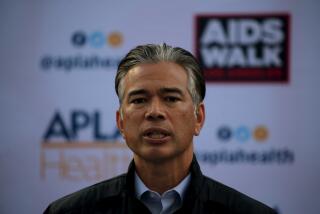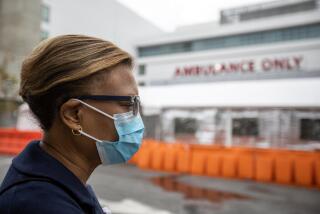Managerial Hand Nurses Summit to Full Recovery : Health-Care Chain Has 2 Santa Ana Hospitals, New Outpatient Surgery Site in Westminster
- Share via
“I’m done talking about a turnaround,” says Donald J. Amaral, president of Summit Health Ltd. “It’s time for us to start growing this business.”
This business is the 12 hospitals, 17 nursing homes and four retirement centers run by Summit, a Burbank-based company that hired Amaral three years ago when it was in big trouble.
Summit was choking on excessive debt and mired in losses. In fiscal 1988 and 1989 (ended June 30), the company lost a combined $15 million while its revenue stagnated at $375 million. Summit’s stock traded for as low as $1 a share, down from $14 four years earlier. Morale among the company’s 5,000 employees flagged.
“The company had the mentality of just wanting to survive the next month,” Amaral recalled. “They didn’t want to win.”
Today, Summit is, well, fully recovered. Profitable again, the company’s earnings leaped from $2.4 million in fiscal 1990 to $11.2 million in fiscal 1992, as revenue jumped 21% over the two years to $452.3 million.
Amaral, a bearded, stocky 40-year-old, said the company’s rebound resulted from three main steps. First, the company is now focusing on “outpatient services” that don’t require an overnight stay, which each of its hospitals could provide profitably.
In fact, Summit Health recently opened its first outpatient surgery center in Westminster. That facility treats as many as 10 patients a day in its two operating rooms. Amaral promises that the Magnolia Outpatient Surgery Center will be duplicated in other areas of California through Summit Health’s new subsidiary, Summit Ambulatory Network.
Amaral also said that the company has spent millions of dollars to upgrade the facilities’ plant and equipment.
And third, Summit has cut its debt, giving it more room to maneuver. Much of the debt had been amassed during an acquisition binge by Summit during the mid-1980s, but several of the acquired properties were loss-ridden and later divested.
The company’s long-term debt, an onerous $142.3 million in mid-1988, now stands at $56 million, or only half the size of Summit’s net worth of $102.5 million. The stock, traded on the NASDAQ market, has climbed back to nearly $8 a share, and its semiannual dividend of 2 cents a share, suspended in early 1989, has been reinstated.
Summit’s hospitals are located in California, Arizona, Iowa and Texas, and account for about 83% of the company’s total revenue. The company’s Southern California hospitals include Doctors Hospital of Santa Ana, Santa Ana Hospital Medical Center, St. Luke Medical Center in Pasadena, Midway Hospital Medical Center in Los Angeles and Whittier Hospital Medical Center.
Jack Olpin, chief executive officer for Doctors Hospital and Santa Ana Hospital Medical Center, said that Amaral’s style of management has helped the sister Orange County facilities make important business decisions that have kept them afloat when other hospitals have experienced declines.
“Don believes in local autonomy,” Olpin said. “But he is there to help us. He is really the driving force behind Summit.”
Among changes underway at the two hospitals, Olpin said, are a major remodeling of maternity facilities and an effort to develop a bilingual staff to serve the heavy concentration of Latino patients.
The balance of Summit’s revenue comes from the nursing homes and retirement centers, which are spread throughout California and Texas, and include the Woodland Care Center in Reseda.
Some analysts said there’s another factor to Summit’s rebound: Amaral himself. “The key to the growth of this company, I think, is him,” said Richard W. Edelman, senior vice president of Southwest Securities Corp., a regional brokerage in Dallas. “He brings a combination of cost controls, a financial background and marketing savvy.” Amaral came to Summit after being president of Mediplex Group Inc., a Newton, Mass., operator of health-care facilities.
To help pare Summit’s debt, Amaral successfully spun off 48% of the company’s nursing-home unit, Summit Care Corp., to the public early this year in a stock offering. Summit Care used $19 million of the proceeds to pay off bills that had formerly saddled Summit Health’s balance sheet.
Yet for all of Summit’s improvement, the company still gets a wary eye from Wall Street. The company’s stock remains a shade below the $9-a-share level it reached early this year and still trades for a moderate 16 times the earnings per share that analysts expect Summit to earn in fiscal 1993.
One reason for the cautious attitude: Summit’s profit, despite growing steadily, amounted to only 2.5 cents per dollar of revenue in fiscal 1992. By contrast, the research firm Value Line Investment Survey expects the publicly held medical-services companies it follows to report an average profit margin of 5.5% this year.
But analysts said there’s a bigger reason: Bill Clinton. There are strong suggestions that the nation’s health-care policies, particularly those regarding government reimbursement, could change under Clinton’s administration.
So stock prices of Summit and many other health-care companies “reflect a wait-and-see attitude by investors relative to what kind of reimbursement controls will be placed on these kinds of companies,” said Edelman.
Amaral’s best guess about Clinton-led changes is that the government will continue putting pressure on limiting health-care costs, in part by steering more groups of people to health maintenance organizations, or HMOs, that provide coverage with selected doctors and hospitals whose reimbursement is controlled. That means Summit must keep improving its service so that more of those HMOs will use its hospitals.
“The efficient companies that work with the successful HMOs will be the major winners,” he predicted.
How did Amaral find the cash to pay for Summit’s improvements?
Generating cash was never a problem at Summit, he said. “In the last three years we’ve thrown off in excess of $90 million of free cash flow that we’ve used to pay our debt down,” he said.
“At the same time, however, we haven’t cut the capital budgets” that determine how much Summit spends on plant and equipment, he added. Indeed, capital spending widened to $23 million in fiscal 1992 from $12 million two years earlier.
It was how Summit utilized its cash that had caused the company problems. In a nutshell, the company was not using its facilities efficiently.
There’s a premium for hospitals to get patients in and out as quickly as possible, a strategy that’s certainly been aided by ongoing improvements in medical-equipment technology. But it also is a strategy that Summit previously was slow to embrace until Amaral showed up.
It’s been critical to Summit’s profitability because in recent years, government health-reimbursement policies and so-called managed care health insurance programs, such as HMOs, have increasingly capped how much hospitals and physicians get paid. So Summit’s ability to raise prices typically comes only once every year or two as the contract is renegotiated. The hospital gets one predetermined fee for each procedure whether a patient stays for four hours or four nights.
“That’s the direction my business is going,” Amaral said. “Payers cannot afford to have someone sit in a hospital for a number of days to have their gall bladder removed.”
The new focus at Summit’s hospitals includes an increase in the number of outpatient services each hospital offers: that gall bladder surgery, for instance, and certain gynecological and arthroscopic procedures.
“Amaral realized that inpatient days were inexorably going to lessen,” said Nancy Moyer, an analyst with the investment firm Ladenburg, Thalmann & Co., which co-managed Summit Care’s stock sale.
Consider St. Luke Medical Center in Pasadena. “We had an antiquated facility,” Amaral said, so Summit built new operating rooms, recruited new doctors, reopened a previously closed obstetrics wing and aggressively promoted the hospital’s orthopedic services. And many of those procedures are conducted on an outpatient basis.
Summit also is scheduling more operations during its hospital’s non-peak times, such as during the evening and on weekends. That not only increases each room’s utilization, it also makes patients happier because they don’t miss workdays, Amaral said.
Unlike Summit’s hospitals, which get most of their revenue from government agencies and health insurers, the nursing homes rely more heavily on an individual’s payments. For that reason, Summit has to compete mostly by offering the best service.
Nursing homes also are “very much of a location business,” Amaral said. “If you’re on the wrong side of the tracks in the nursing-home business, it’s very difficult to get people to bring their loved ones across those tracks.”
Summit also has a bit more flexibility in raising prices at its nursing homes compared with the hospitals, but plenty of nearby rivals have limited their annual price hikes to about 5% or 6% for the past three years, Amaral said.
The company’s nursing homes also have the nation’s demographics working in their favor.
A Census Bureau report released early this month noted that people aged 85 and older will be a dramatically expanding segment of the population over the next 30 years. That means their old-age illnesses “are likely to produce a need for prolonged care for many people,” the agency said.
Times staff writer James M. Gomez contributed to this report.
More to Read
Inside the business of entertainment
The Wide Shot brings you news, analysis and insights on everything from streaming wars to production — and what it all means for the future.
You may occasionally receive promotional content from the Los Angeles Times.











